Table of contents:
Key takeaways:
- Leverage Riverside for high-quality videos: Use Riverside to record in 4K video and 48 kHz audio, then edit with tools like text-based trimming, aspect ratio adjustments (9:16 for TikTok), and Magic Clips for creating short, shareable content.
- Keep videos short and catchy: Aim for 21-34 seconds in length and hook viewers within the first three seconds to maximize retention and performance on TikTok’s algorithm.
- Incorporate trending sounds and hashtags: Stay on top of audio trends and use 3-5 relevant hashtags per post to increase your content’s visibility on the For You page.
- Enhance accessibility with text overlays: Use bold, colorful text overlays and captions to emphasize key points, cater to sound-off viewers, and make your videos more inclusive.
Editing TikTok videos can be quick and fun when you know the basics. From trimming and adding effects to formatting your video correctly, this guide simplifies the process step-by-step.
Dive in to learn how to create polished, eye-catching videos with ease.
How to edit videos on TikTok
TikTok’s built-in video editor is surprisingly powerful. Let’s look at how to use TikTok’s editing tools to elevate your content.
Step 1: Open the TikTok app and start a TikTok
Open the TikTok app. Press the “+” button at the bottom of the screen.

Step 2: Record your TikTok or select a video
You can either record a video or upload videos already on your phone.

To record a video, choose your video length from 15 seconds, 60 seconds, or up to 10 minutes. Alternatively, press and hold the white camera button to start recording. To stop recording, leave the button.
To upload a video, just click on the image in the bottom right corner, and in the following screen, choose from among the videos on your phone.
Step 3: Choose between automatic and manual editing
On the next screen, you’ll see an option called “AutoCut.” This AI-powered feature automatically applies effects, music, and transitions to create a polished montage.

For manual editing, click “Next.” Then, tap the “Edit” button on the side panel on the following screen.

Step 4: Trimming and splitting
Now click on the scissor icon.

You can trim the video by dragging its edges. To split the video, drag the play head to the section you want to split and click the “Split” button.
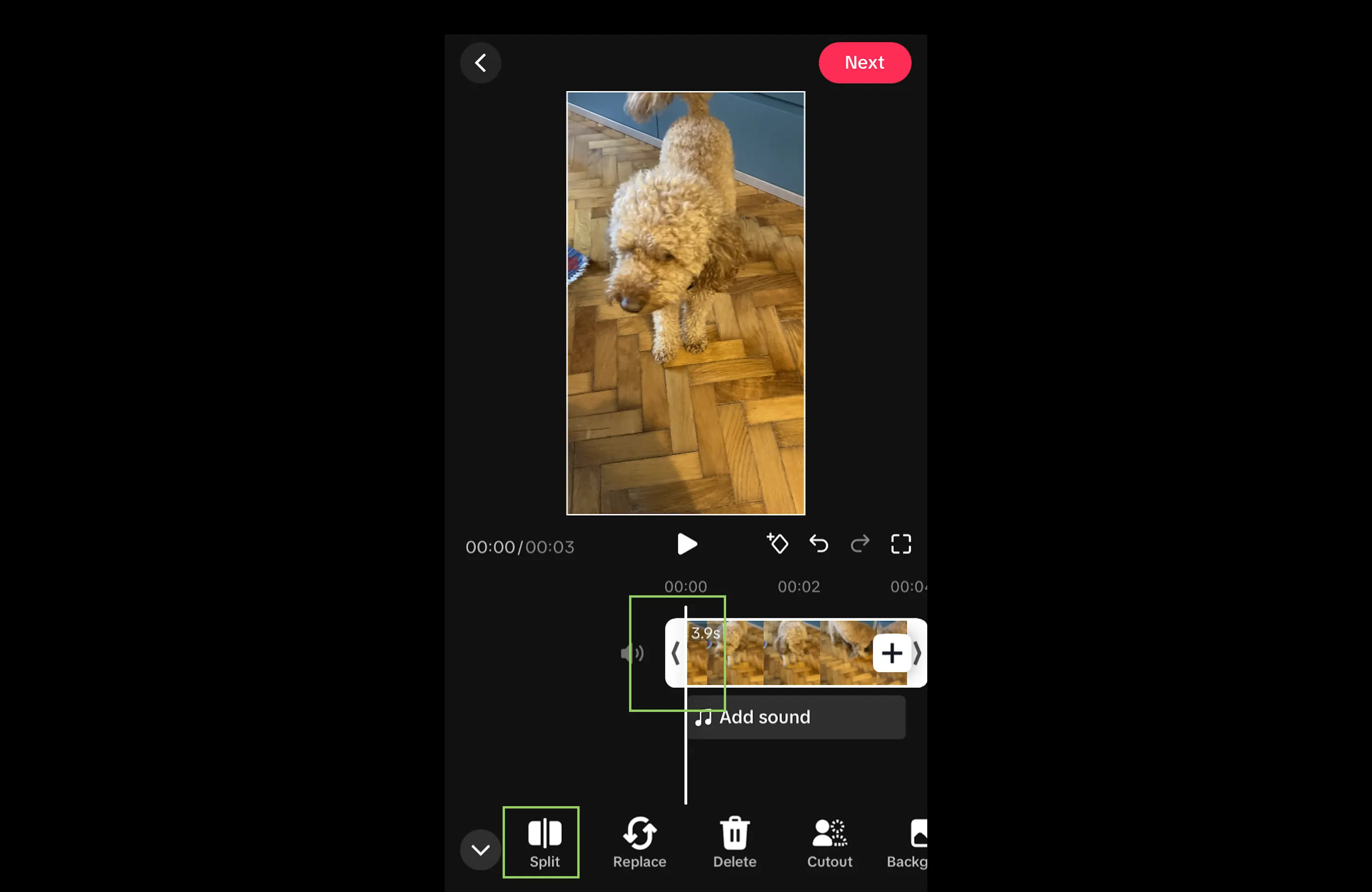
Step 5: Add text and change captions
Return to the main editing screen, click the “Text” button, and click “Add text”.
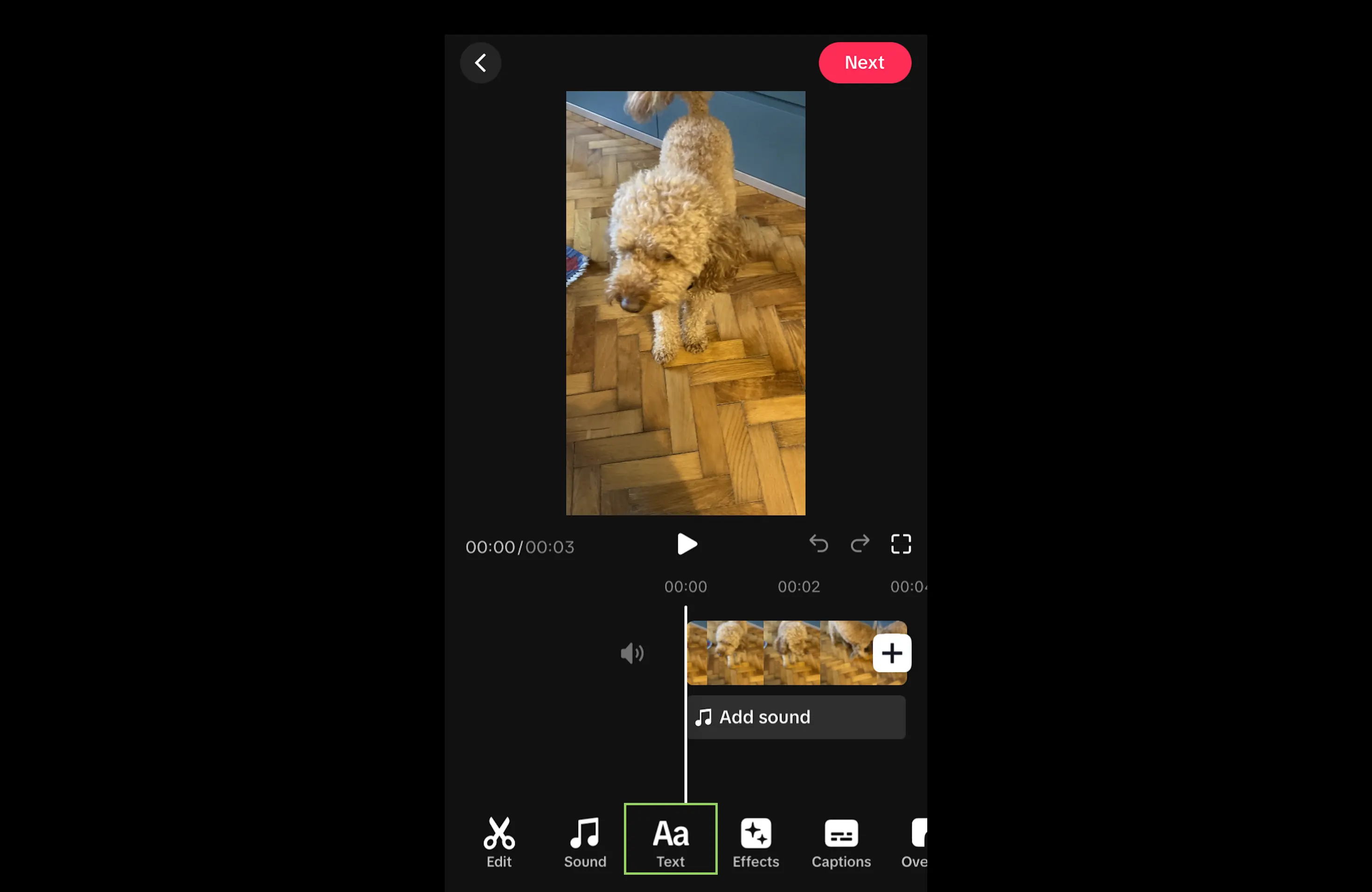
After clicking “Text,” you can type the text and change the color and font.
To add captions, click “Captions”.
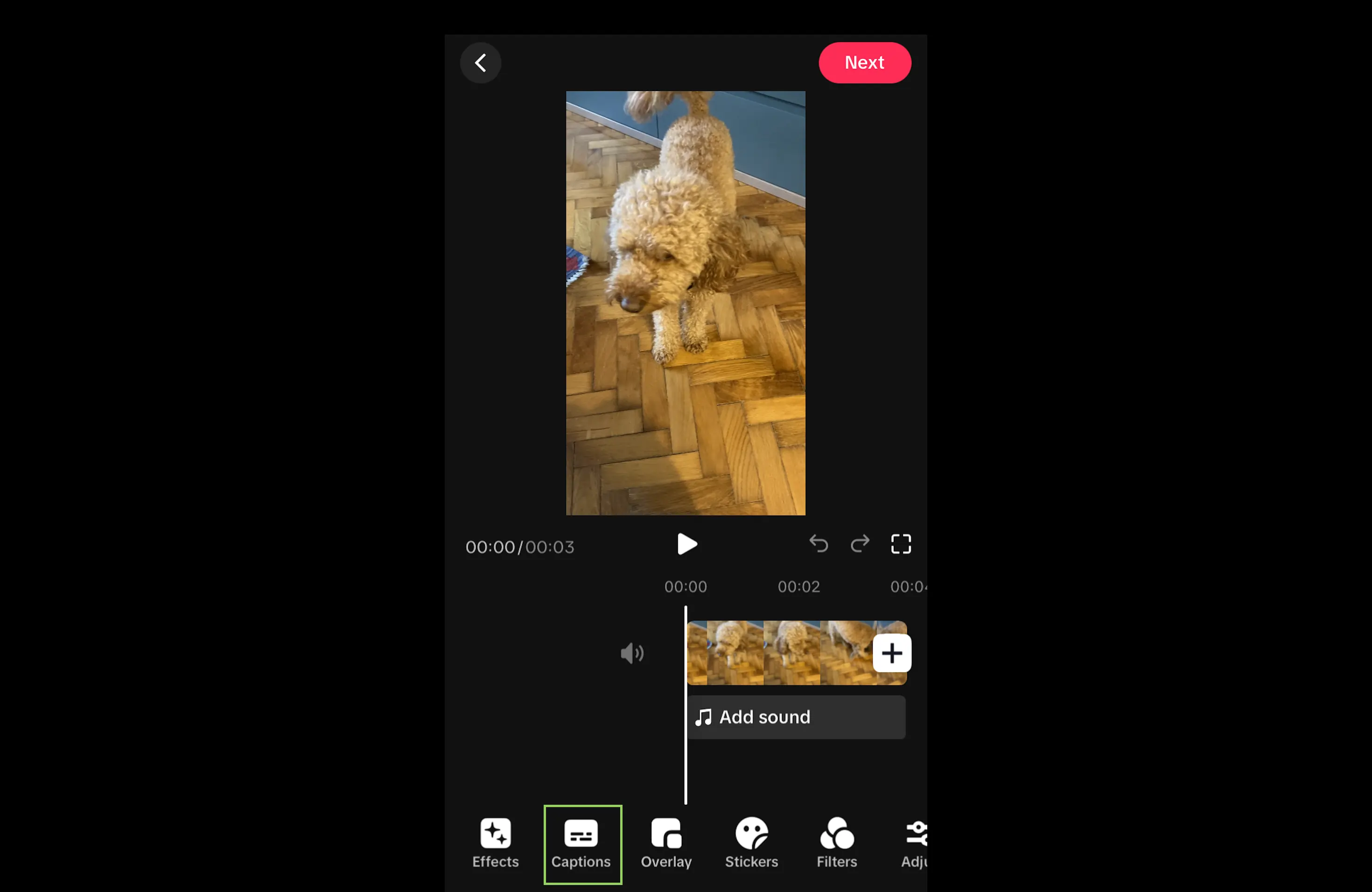
After clicking on “Captions,” wait for the captions to generate. Then, you’ll come to the caption editing screen. Click on the generated captions to edit them, and change the font or colors, similar to the text section above.
Step 6: Add effects and filters
Click on “Effects” to add effects and “Filters” to add filters.
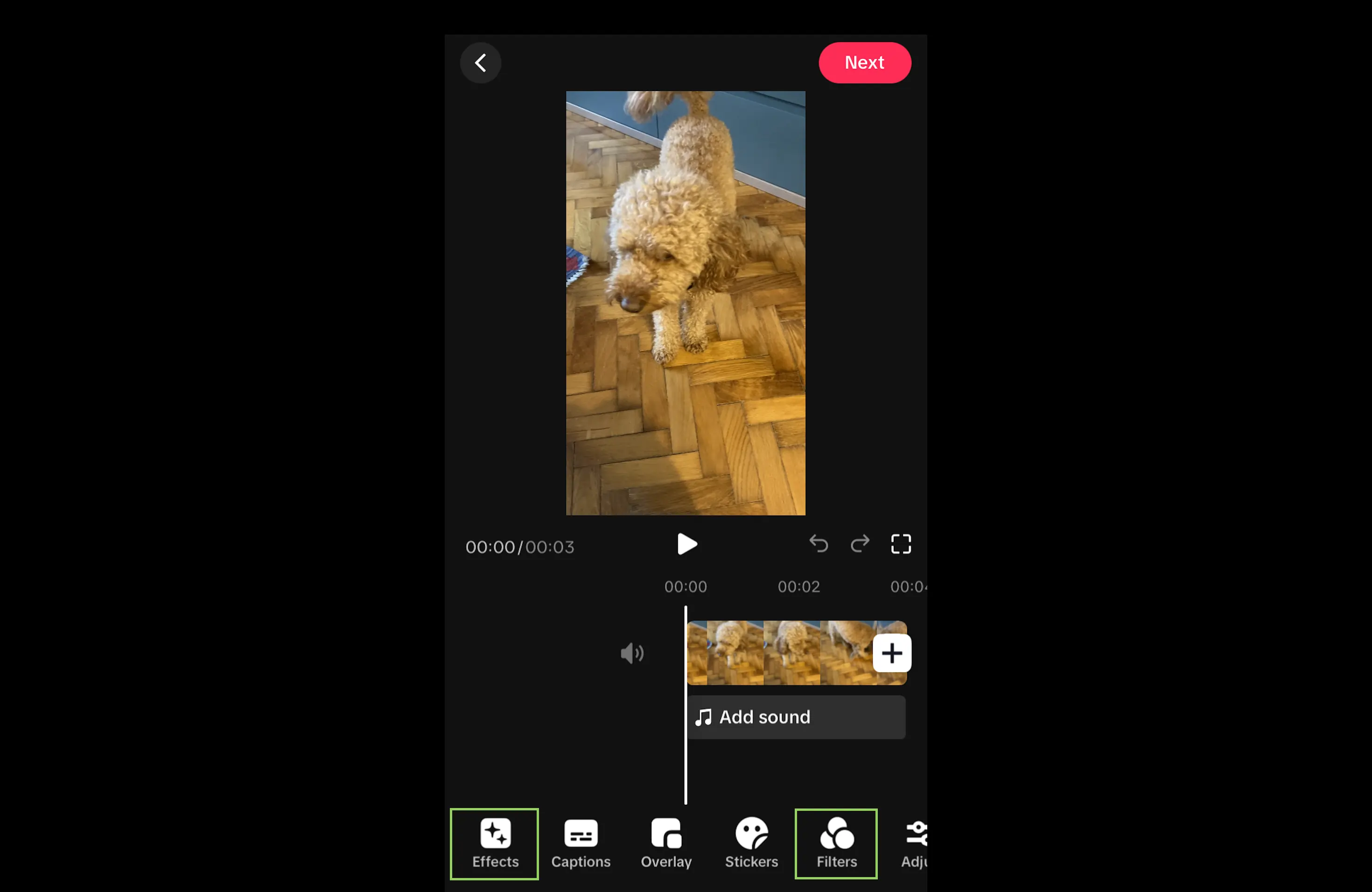
On the effects page, choose among the various effects. If you want to add more effects, click “Add effects.” You can position the subsequent effects on a different part of the timeline or make them overlap with the other effects.

To add filters, go to “Filters” and select one of the various options. You can add more filters by pressing “Filters” again and placing them in the same or different portion of the timeline.
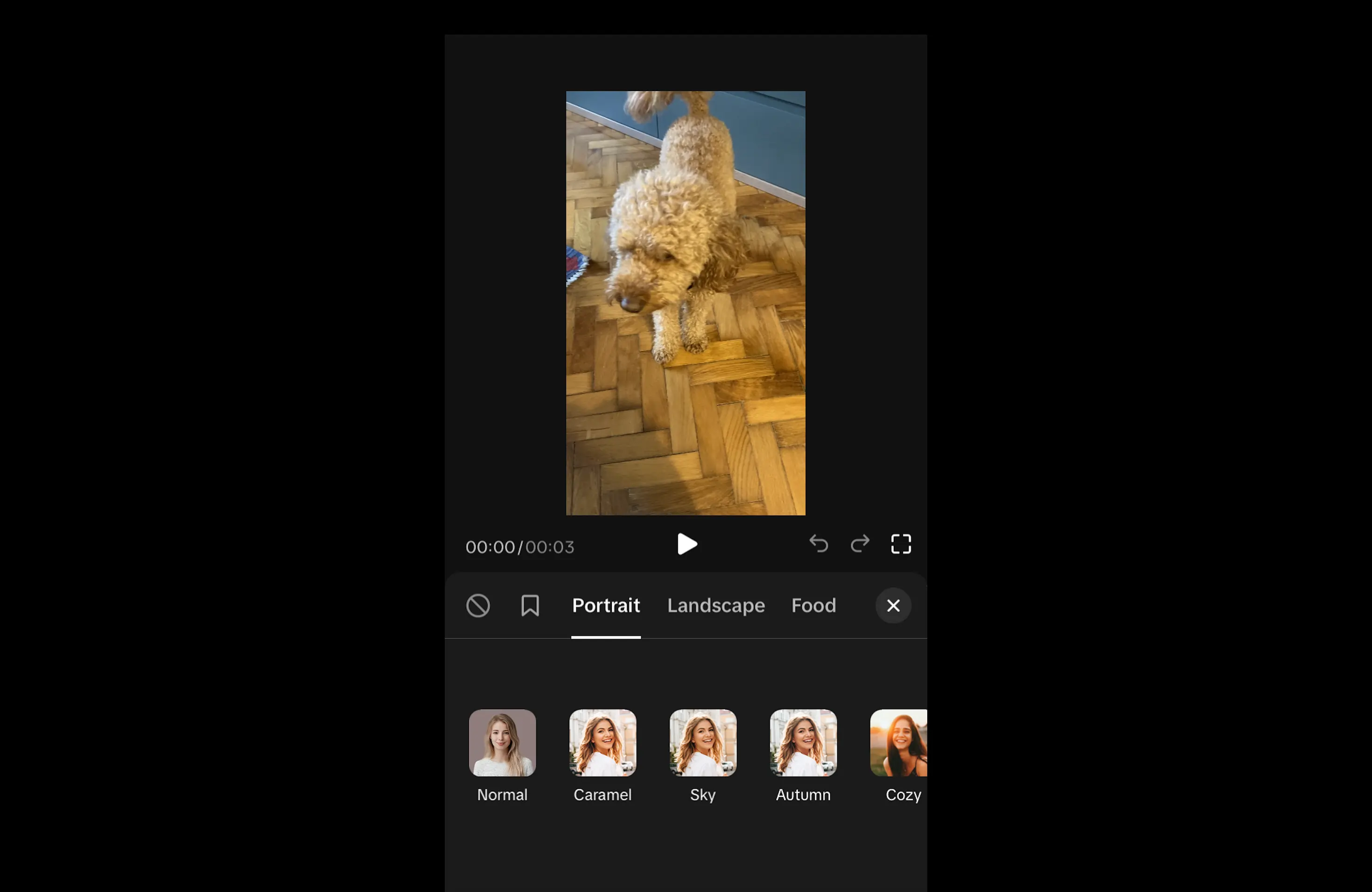
How to edit TikTok videos with Riverside
Riverside is a fantastic platform for recording high-quality audio and video and uploading it to TikTok. It can record 4K video and 48 kHz lossless audio, producing crisp and clear production quality that will make your content pop and stand out.
Key features and benefits of Riverside for shooting and recording TikTok videos include:
- Magic Clips: Generate short, shareable clips from longer videos using AI. Instantly upload these to TikTok.
- Record multiple people: Record remotely multiple people, making it great for shooting interview-style videos. Can record up to 10 people.
- Screen recording: Record your screen, which is ideal for shooting tutorials or explainer videos.
- Text-based editing: You can trim and cut the video simply by deleting the text in the automatically generated transcript. This method is excellent for precise editing.
- Multi-track editing: Ideal for interviews, podcasts, or multi-speaker content.
Let’s look at how you can edit videos on Riverside, optimize for TikTok, and upload them to the platform.
Step 1: Log in to your Riverside account
Create an account with Riverside and log in. Then click on “Create Studio.” Add your name, choose your settings, and click “Create.”
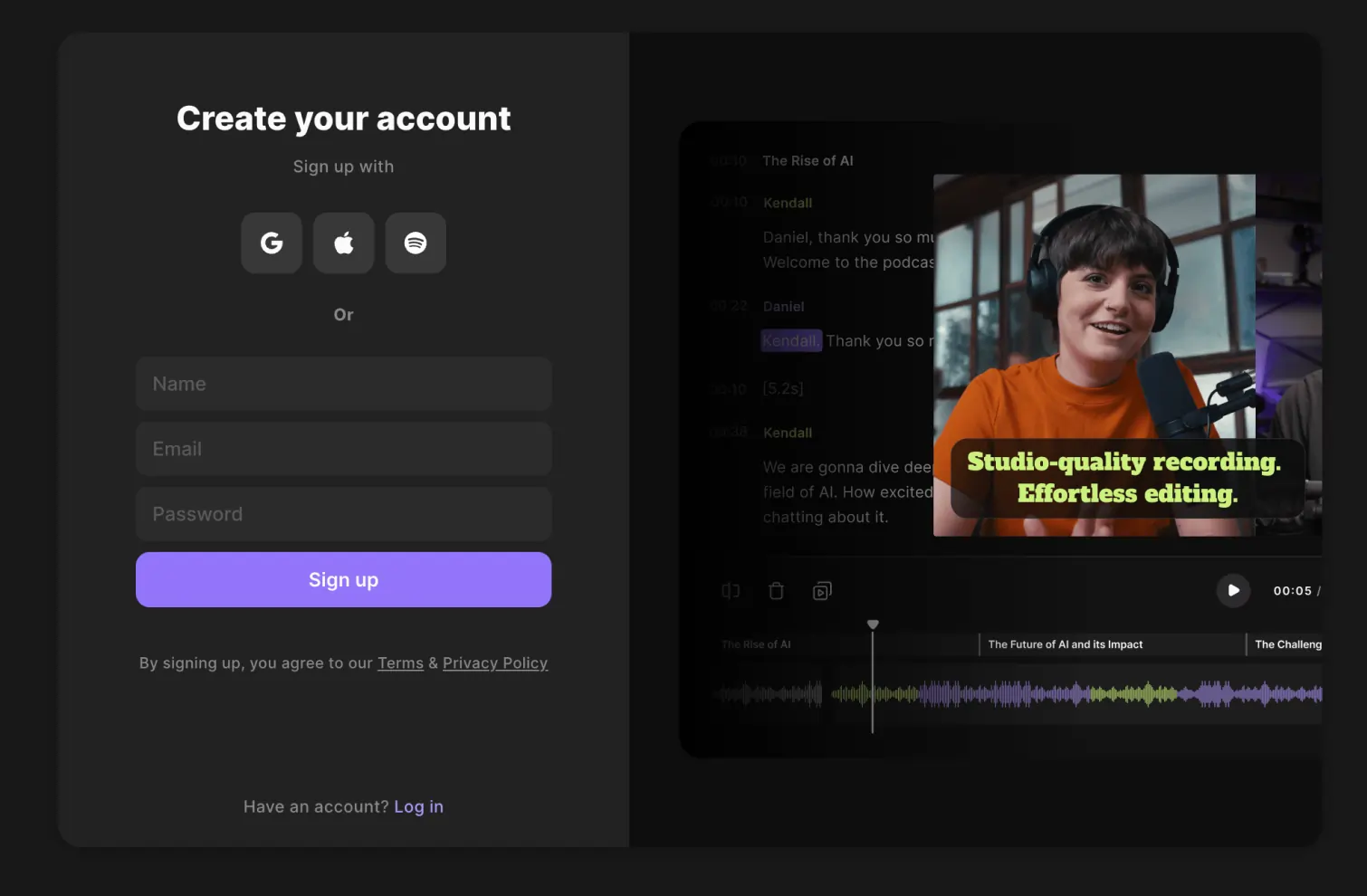
Step 2: Record your video
Click on “Record.” Change your camera and mic settings, then click “Join Studio.”
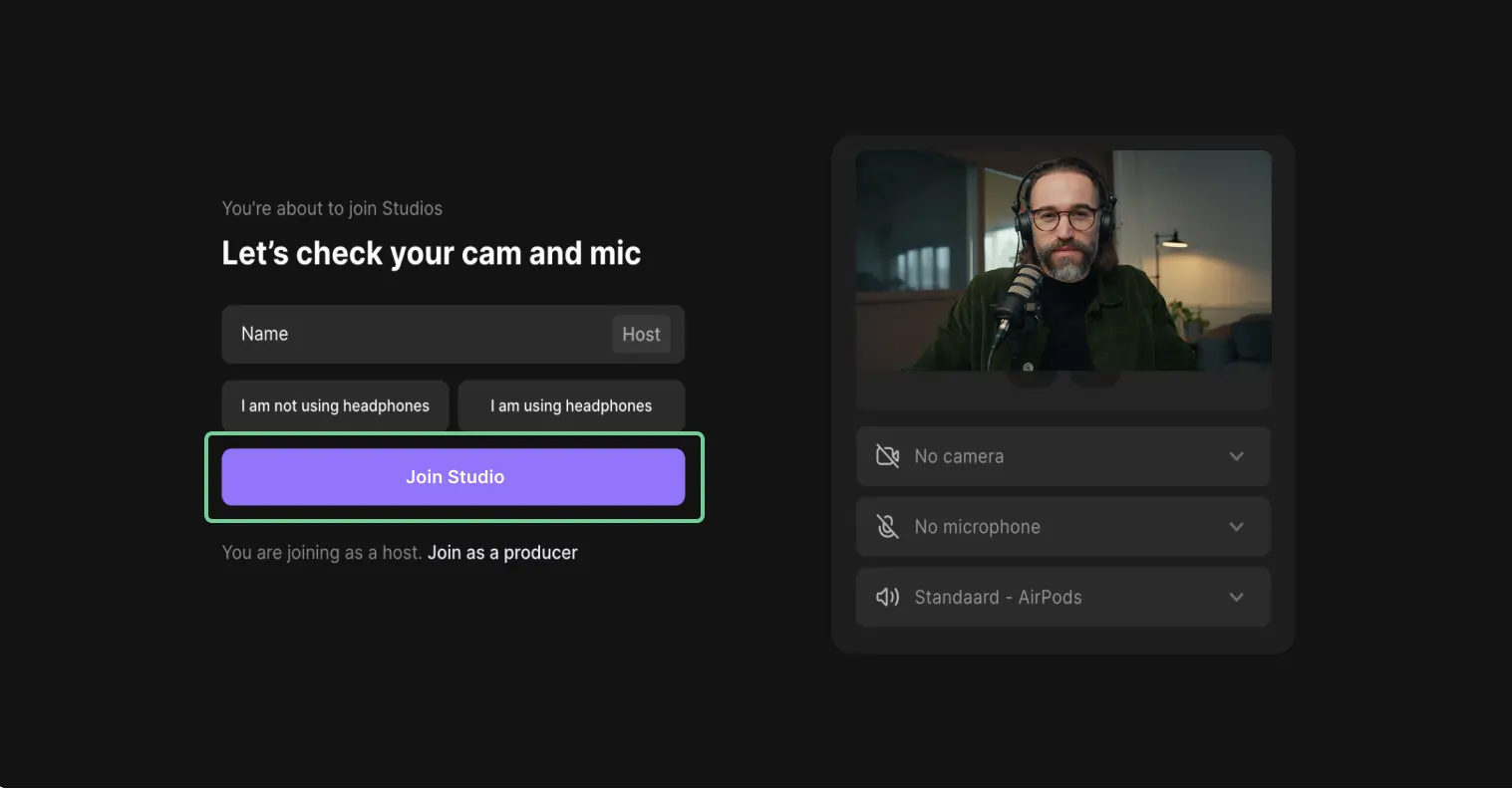
On the following screen, click “Record.”
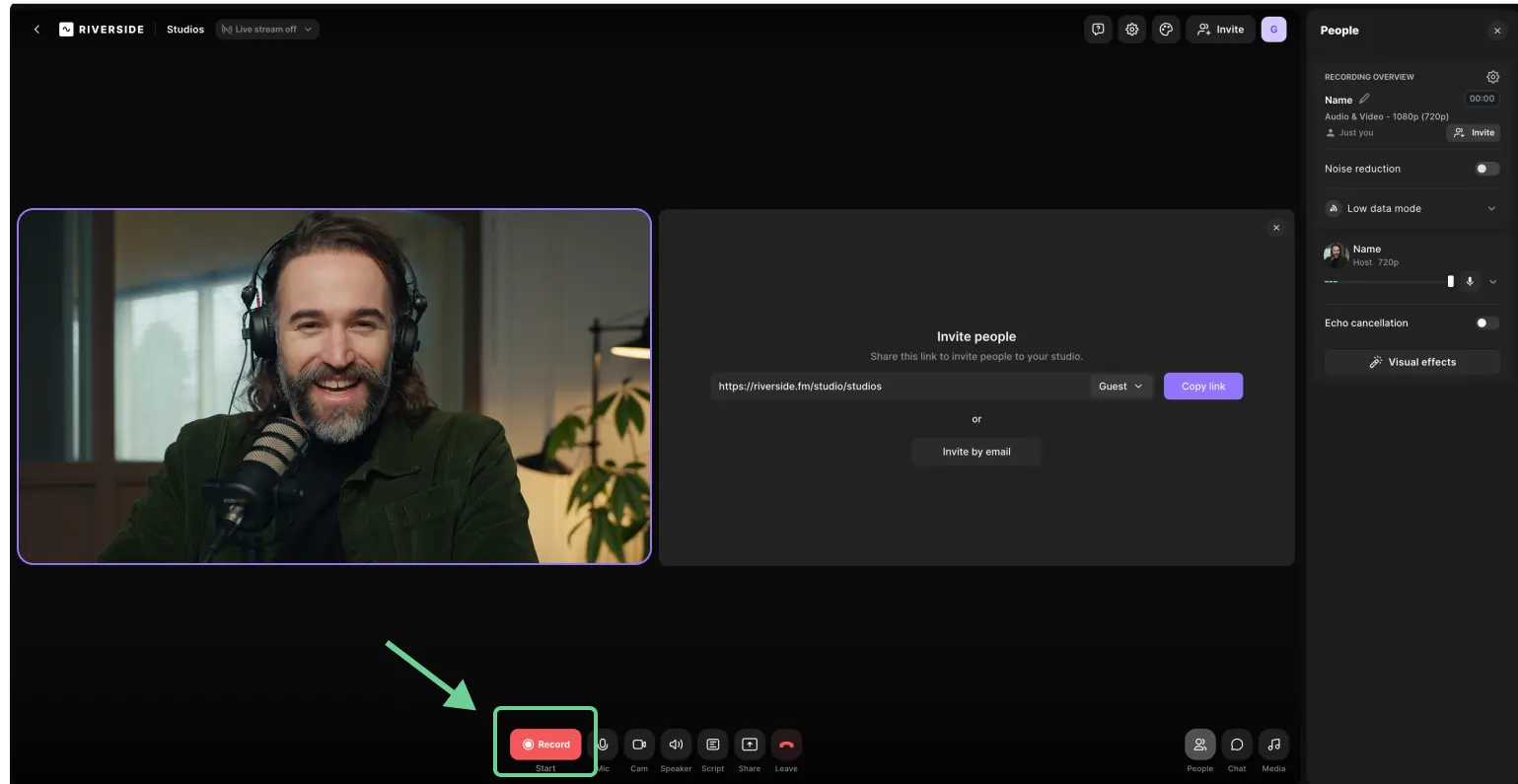
Step 3: Stop your recording
Once the recording is done, hit “Stop” > “Leave” > “End session for all.”
Wait for Riverside to upload the video to the cloud. Once done, click on the video, then click on the purple “Edit” button.
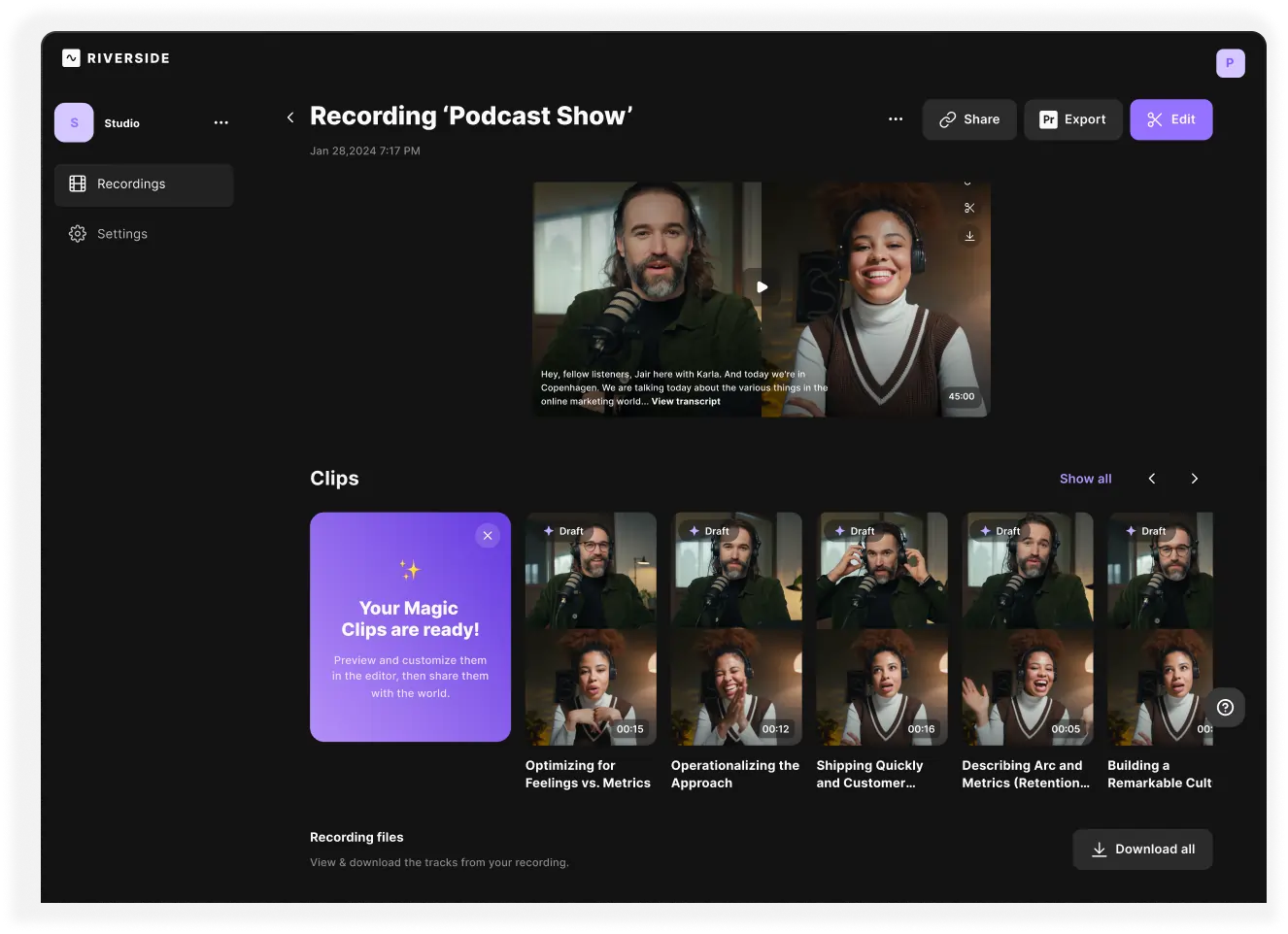
Step 4: Edit and add captions
You’re now in the Riverside Editor. To add captions, click the “Captions” button on the right sidebar. Then, choose between various fonts and formats.
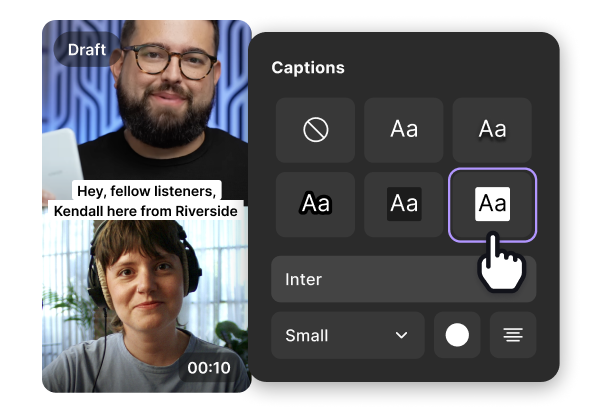
Step 5: Change video aspect ratio
Since you’ll be uploading the video to TikTok, you’ll need to change the aspect ratio. Riverside makes this easy. Just click the aspect ratio button at the top and choose 9:16.
.webp)
Step 6: Enhance audio
To enhance the audio of your recording, click “AI Producer” on the sidebar and click “Magic Audio.” This makes your audio sound like it was recorded in a professional studio.
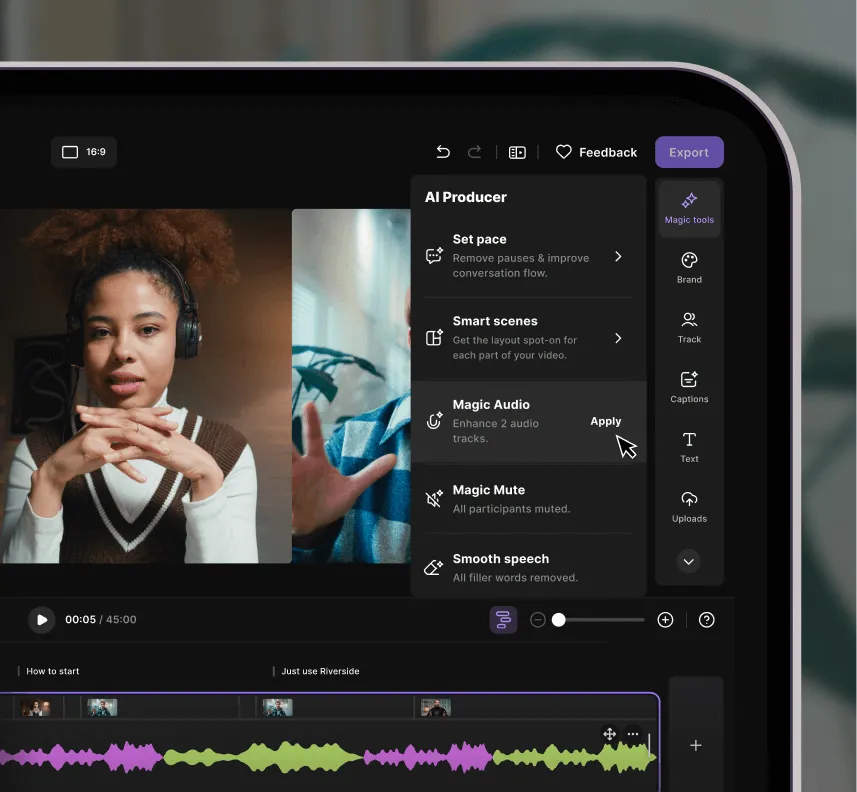
Step 7: Add overlays
To add image overlays, go to “Images” on the sidebar and either upload an image or choose one from royalty-free videos.
To add text overlays, click the “Text” tool on the right sidebar and choose from the various options. Position this text anywhere in the frame.

Step 6: Trimming
Click and drag the edges of the clip to trim it. You can also trim the clip using the text-based editor. Just delete the words you don’t want in the clip to have the corresponding portion of the video deleted.

Step 7: Add images, audio, and video
Add audio, video, and images to the video by pressing the “Upload” button on the sidebar and choosing from files on your desktop.
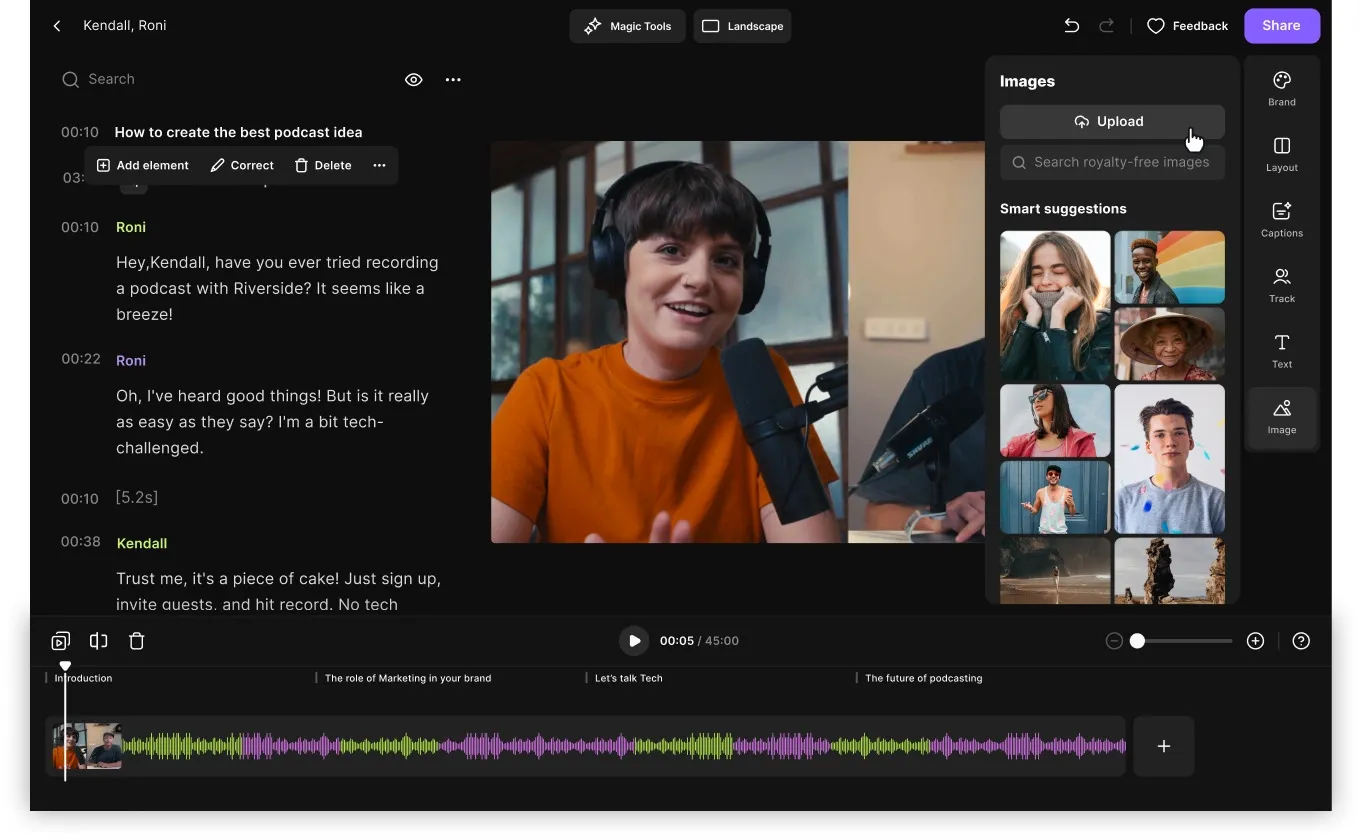
Step 8: Export your video
And that’s it! All you have to do now is export the video. Click “Export.” Then, select among the various options, including normalizing audio and removing background noise. Choose 1080p as the video quality, as this is the maximum video resolution that TikTok accepts.
Then click “Export video.” A pop-up will appear saying, “Export your edit.” Click on “Go to exports.”
Step 9: Move your video to TikTok
You’ll find the exported video in the “Edits” section. Tap the “Share” button, and click on TikTok on the following screen. You should now be able to post your video on TikTok.
If you have more extended footage and want to make TikTok videos from them, you can use Magic Clips to create short, viral-worthy clips automatically.
To create Magic Clips, go to Studio, click on the recording, scroll down, and click “Generate clips.” Choose the duration, speaker, type the topic to be highlighted, and then wait for the clips to be generated.
Best practices for editing TikTok videos to boost engagement
The secret to success on TikTok isn’t just about adding trending sounds or eye-catching effects (though they sure play a part). Strategic editing plays a crucial role in grabbing attention and keeping viewers hooked. Here’s what you need to know.
Keep it short and snappy
Want your TikTok videos to perform well? Wired reports that the sweet spot in terms of optimal length is 21 to 34 seconds, with one in four top-performing videos falling within that range. That’s because attention spans are getting shorter and shorter nowadays.
So keep videos snappy! Quick, engaging edits are key to staying competitive for the algorithm. Cut out any fluff – long pauses, slow moments, anything that fails to keep viewers hooked. Get to the point and make every second count!
Add captions and text overlays
Use captions and text overlays to make your videos more accessible and engaging. They benefit everyone, including those who are hard of hearing, those watching with sound off, and those who struggle focusing.
Text overlays, especially with colorful and bold text, help emphasize information. Experiment with different colors, fonts, and animation to make your text pop and match the tone of your video.
Use trending sounds and effects
Videos with trending sounds get 66% more engagement than those without. This increases your chances of being featured on the “For You” page (FYP).
There are many ways to decide which song you should choose for your video:
- Analyze the "For You Page," especially those videos similar to yours.
- Check out what sounds the competitors in your niche are using.
- Stay on top of emerging audio trends relevant to your content.
- Try different trending sounds and see which ones perform well with your audience.
Use hashtags and keywords
Use a mix of relevant and trending hashtags. These increase your visibility on TikTok’s For You Page (FYP). Using irrelevant hashtags can confuse the algorithm and annoy viewers.
Ideally, for optimal performance, use 3-5 hashtags per post. These could be 1-2 popular, trending hashtags and 2-3 niche-specific ones.
Add keywords in captions to boost discoverability. As a bonus, place keywords strategically in the beginning. This can help you catch the viewer’s attention. Also, incorporate keywords seamlessly into your text to maintain readability.
Filters, effects, and transitions
Creatively use filters and effects to enhance your video, but don’t overdo it. Subtle enhancements often work best.
Create a strong hook in the first three seconds
The first three seconds of your video are crucial – they must capture attention immediately to prevent viewers from scrolling past. So, focus on creating a strong hook that draws viewers in and clearly communicates what they can expect from your video.
FAQs about editing TikTok videos
Does TikTok have a video editor?
Yes, TikTok has a built-in video editor that allows you to create and edit videos directly within the app. Some of the main features of the editor include:
- Trimming and splitting clips
- Text overlays and captions
- Music and sound effects
- Speed adjustments
- Filter, effects, and transitions
Where is the video editor on TikTok?
To access the video editor on TikTok, follow these steps:
- Open the TikTok app. Press the “+” button at the bottom of the screen.
- Either upload a video from your phone or record one.
- In the following screen, click next. Then, choose “Edit” from the sidebar. You now have access to TikTok’s editor.
Can I edit TikTok videos after they’ve been posted?
Once a video is posted, editing capabilities are limited. You can only:
- Edit the caption
- Modify hashtags
- Change the cover image
- Change mentions

.webp)













.webp)
.webp)


.webp)
.webp)


